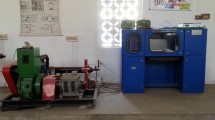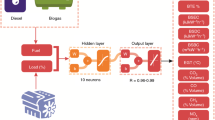Abstract
In this work, six computational models based on artificial neural networks were developed to simulate an operating diesel engine fuelled with 8% biodiesel in order to predict performance and emissions of a diesel–biodiesel engine in a group generator. The ANN models were used to simulate a diesel–biodiesel engine that has four cylinders with a volume of 3.9 l, a compression ratio of 17:1, direct injection, and a rated power of 49 kW. The models were validated against experimental data for 10 kW, 20 kW, and 30 kW loads. The models were capable of accurately predicting the output power, thermal efficiency, and emissions of CO2, CO, NO, and NOx. Their comparison with experimental results showed a satisfactory agreement and the reliability of their predicted results for new operating conditions.






Similar content being viewed by others
References
Amari S, Murata N, Muller KR, Finke M, Yang HH (1995) Statistical theory of overtraining—is cross-validation asymptotically effective? In: Proceedings of the 8th international conference on neural information processing systems November, NIPs, pp 176–182
Amari S, Murata N, Muller KR, Finke M, Yang HH (1997) Asymptotic statistical theory of overtraining and cross-validation. IEEE Trans Neural Netw 8(5):985–996
An H, Yang WM, Li J (2015) Numerical modeling on a diesel engine fueled by biodiesel–methanol blends. Energy Convers Manag 93:100–108. https://doi.org/10.1016/j.enconman.2015.01.009
Benson RS, Annand W, Baruah P (1975) A simulation model including intake and exhaust systems for a single cylinder four-stroke cycle spark ignition engine. Int J Mech Sci 17(2):97–124. https://doi.org/10.1016/0020-7403(75)90002-8
Bittencout FR, Zárate LE (2011) Hybrid structure based on previous knowledge and GA to search the ideal neurons quantity for the hidden layer of MLP—application in the cold rolling process. Appl Soft Comput 11(2):2460–2471. https://doi.org/10.1016/j.asoc.2010.10.002
Canakci M, Ozsezen AN, Arcaklioglu E, Erdil A (2009) Prediction of performance and exhaust emissions of a diesel engine fueled with biodiesel produced from waste frying palm oil. Expert Syst Appl 36(5):9268–9280. https://doi.org/10.1016/j.eswa.2008.12.005
Çay Y, Çiçek A, Kara F, Sağiroğlua S (2012) Prediction of engine performance for an alternative fuel using artificial neural network. Appl Therm Eng 37:217–225. https://doi.org/10.1016/j.applthermaleng.2011.11.019
Ebrahimi M, Najafi M, Jazayeri S (2018) Artificial neural network to identify RCCI combustion mathematical model for a heavy-duty diesel engine fueled with natural gas and diesel oil. J Braz Soc Mech Sci Eng 40:407. https://doi.org/10.1007/s40430-018-1328-9
Ganesan V (2000) Computer simulation of compression–ignition engine processes. Universities Press, Cambridge
Ghobadian B, Rahimi H, Nikbakht AM, Najafi G, Yusaf TF (2009) Diesel engine performance and exhaust emission analysis using waste cooking biodiesel fuel with an artificial neural network. Renew Energy 34(4):976–982. https://doi.org/10.1016/j.renene.2008.08.008
Gurney K (1997) An introduction to neural networks. CRC Press, Boca Raton
Haykin S (1999) Redes Neurais, Princípios e prática. Bookman. ISBN 0-13-273350-1
Heywood JB (1988) Internal combustion engine fundamentals. Mcgraw-Hill, New York
Hornik K, Stinchcombe M, White H (1990) Universal approximation of an unknown mapping and its derivatives using multilayer feedforward networks. Neural Netw 3(5):551–560
Ismail HM, Ng HK, Queck C, Gan S (2012) Artificial neural networks modelling of engine-out responses for a light-duty diesel engine fuelled with biodiesel blends. Appl Energy 92:769–777. https://doi.org/10.1016/j.apenergy.2011.08.027
Jo Y, Min K, Jung D, Sunwoo M, Han M (2019) Comparative study of the artificial neural network with three hyper-parameter optimization methods for the precise LP-EGR estimation using in-cylinder pressure in a turbocharged GDI engine. Appl Therm Eng 149:1324–1334. https://doi.org/10.1016/j.applthermaleng.2018.12.139
Kakati D, Roy S, Banerjee R (2019) Development of an artificial neural network based virtual sensing platform for the simultaneous prediction of emission-performance-stability parameters of a diesel engine operating in dual fuel mode with port injected methanol. Energy Convers Manag 184:488–509. https://doi.org/10.1016/j.enconman.2019.01.087
Karthickeyan V, Balamurugan P, Rohith G, Senthil R (2017) Developing of ANN model for prediction of performance and emission characteristics of VCR engine with orange oil biodiesel blends. J Braz Soc Mech Sci Eng 39:2877–2888. https://doi.org/10.1007/s40430-017-0768-y
Kim DH, Lee Y, Kim BM (2002) Applications of ANN for the dimensional accuracy of workpiece in hot rod rolling process. J Mater Process Technol 130–131:214–218. https://doi.org/10.1016/S0924-0136(02)00724-0
Kohavi R (1995) A study of cross-validation and bootstrap for accuracy estimation and model selection. In: International joint conference on artificial intelligence, vol 14, pp 1137–1145
Lage C, Sodré J (2016) Development of a graphical user interface for diesel engine simulation. SAE Technical Paper 2016-36-0136. https://doi.org/10.4271/2016-36-0136
Lenard JG, Zhang S (1997) A study of friction during the lubricated cold rolling of an aluminum alloy. J Mater Process Technol 72:293–301. https://doi.org/10.1016/S0924-0136(97)00183-0
Lionus Leo GM, Sekar S, Arivazhagan S (2018) Experimental investigation, optimization and ANN model prediction of a gasoline premixed waste cooking oil fueled HCCI–DI engine. J Braz Soc Mech Sci Eng 40:49. https://doi.org/10.1007/s40430-018-0967-1
Liu H, Wang X, Zheng Z, Gu J, Wang H, Yao M (2014) Experimental and simulation investigation of the combustion characteristics and emissions using n-butanol/biodiesel dual-fuel injection on a diesel engine. Energy 74:741–752. https://doi.org/10.1016/j.energy.2014.07.041
Luján JM, Climent H, García-Cuevas LM, Moratal A (2017) Volumetric efficiency modelling of internal combustion engines based on a novel adaptive learning algorithm of artificial neural networks. Appl Therm Eng 123:625–634. https://doi.org/10.1016/j.applthermaleng.2017.05.087
Manieniyan V, Vinodhini G, Senthilkumar R, Sivaprakasam S (2016) Wear element analysis using neural networks of a DI diesel engine using biodiesel with exhaust gas recirculation. Energy 114:603–612. https://doi.org/10.1016/j.energy.2016.08.040
Merker G, Schwarz C, Stiesch G, Otto F (2005) Simulating combustion: simulation of combustion and pollutant formation for engine-development. Springer, Berlin
Moody JE (1992) The effective number of parameters: an analysis of generalization and regularization in nonlinear learning systems. In: Moody JE, Hanson SJ, Lippmann RP (eds) NIPS 4: advances in neural information processing systems. Morgan Kaufmann, San Mateo
Myllykoski P, Larkiola J, Nylander J (1996) Development of prediction model for mechanical properties of batch annealed thin steel strip by using artificial neural network modeling. J Mater Process Technol 60:399–404. https://doi.org/10.1016/0924-0136(96)02361-8
Niu X, Yang Ch, Wang H, Wang Y (2017) Investigation of ANN and SVM based on limited samples for performance and emissions prediction of a CRDI- assisted marine diesel engine. Appl Therm Eng 111:1353–1364. https://doi.org/10.1016/j.applthermaleng.2016.10.042
Ng HK, Gan S, Ng JH, Pang KM (2013) Simulation of biodiesel combustion in a light-duty diesel engine using integrated compact biodiesel–diesel reaction mechanism. Appl Energy 102:1275–1287. https://doi.org/10.1016/j.apenergy.2012.06.059
Oğuz H, Saritas I, Baydan HE (2010) Prediction of diesel engine performance using biofuels with artificial neural network. Expert Syst Appl 37(9):6579–6586. https://doi.org/10.1016/j.eswa.2010.02.128
Oliveira A, Marcelino de Morais A, Valente OS, Sodré JR (2015) Combustion characteristics, performance and emissions from a diesel power generator fuelled by B7-ethanol blends. Fuel Process Technol 139:67–72. https://doi.org/10.1016/j.fuproc.2015.08.010
Oliveira A (2015) Desempenho e emissões de um motor Diesel utilizando diferentes técnicas de injeção de etanol. 229 f. Master thesis—Mechanical Engineering Department, Pontíficia Universidade Católica de Minas Gerais, Belo Horizonte. http://www.biblioteca.pucminas.br/teses/EngMecanica_OliveiraA_1.pdf
Parlak A, Islamoglu Y, Yasar H, Egrisogut A (2005) Application of artificial neural network to predict specific fuel consumption and exhaust temperature for a diesel engine. Appl Therm Eng 26(8):824–828. https://doi.org/10.1016/j.applthermaleng.2005.10.006
Patil S (2013) Thermodynamic modelling for performance analysis of compression ignition engine fuelled with biodiesel and its blends with diesel. Int Recent Technol Eng: IJRTE 1(6):134–138
Payri F, Olmeda P, Martín J, García A (2011) A complete 0d thermodynamic predictive model for direct injection diesel engines. Appl Energy 88(12):4632–4641. https://doi.org/10.1016/j.apenergy.2011.06.005
Poggio RT, Girosi F (1990) Networks for approximation and learning. Proc IEEE 78(9):1481–1497
Poggio RT, Girosi F (1990) Regularization algorithms for learning that are equivalent to multilayer networks. Science 247:978–982
Ramadhas A, Jayaraj S, Muraleedharan C (2006) Theoretical modeling and experimental studies on biodiesel-fueled engine. Renew Energy 31(11):1813–1826. https://doi.org/10.1016/j.renene.2005.09.011
Rumelhart DE, Hinton GE, Williams RJ (1986) Learning representations by back-propagating errors. Nature 323(6088):533–536. https://doi.org/10.1038/323533a0
Son JS, Lee DM, Kim IS, Choi SK (2004) A study on genetic algorithm to select architecture of an optimal neural network in the hot rolling process. J Mater Process Technol 153–154:643–648. https://doi.org/10.1016/j.jmatprotec.2004.04.376
Son JS, Lee DM, Kim IS, Choi SK (2005) A study on on-line neural network for prediction for rolling force in hot-rolling mill. J Mater Process Technol 164–165:1612–1617. https://doi.org/10.1016/j.jmatprotec.2005.01.009
Yang YY, Linkens DA, Talamantes-Silva J (2004) Roll load prediction—data collection, analysis and neural network modeling. J Mater Process Technol 152:304–315. https://doi.org/10.1016/j.jmatprotec.2004.04.372
Yusaf TF, Buttsworth DR, Saleh KH, Yousif BF (2010) Cng-diesel engine performance and exhaust emission analysis with the aid of artificial neural network. Appl Energy 87(5):1661–1669. https://doi.org/10.1016/j.apenergy.2009.10.009
Zárate LE, Dias SM (2009) Qualitative behavior rules for the cold rolling process extracted from trained ANN via the FCANN method. Eng Appl Artif Intell 22:718–731. https://doi.org/10.1016/j.engappai.2008.11.009
Zárate LE, Bittencout FR (2008) Representation and control of the cold rolling process through artificial neural networks via sensitivity factors. J Mater Process Technol 197:344–362. https://doi.org/10.1016/j.jmatprotec.2007.06.063
Acknowledgements
The authors thank the Brazilian National Council for Scientific and Technological Development (CNPq), the Coordination for the Improvement of Higher Education Personnel (CAPES), the Foundation of Support Research of the State of Minas Gerais (FAPEMIG), and the Pontifical Catholic University of Minas Gerais (PUC Minas) for the financial support of this project.
Author information
Authors and Affiliations
Corresponding author
Ethics declarations
Conflict of interest
The authors declare that they have no known competing financial interests or personal relationships that could have appeared to influence the work reported in this paper.
Additional information
Technical Editor: Mario Eduardo Santos Martins.
Publisher's Note
Springer Nature remains neutral with regard to jurisdictional claims in published maps and institutional affiliations.
Rights and permissions
About this article
Cite this article
Lage, C.S., de Morais Hanriot, S. & Zárate, L.E. Using artificial neural networks to represent a diesel–biodiesel engine. J Braz. Soc. Mech. Sci. Eng. 42, 575 (2020). https://doi.org/10.1007/s40430-020-02666-y
Received:
Accepted:
Published:
DOI: https://doi.org/10.1007/s40430-020-02666-y




